
Currently (Easter 1998) the program performs 3 main test.
1- Grating Tasks.
2- Contrast Sensitivity Function (CSF) testing.
3- Letter Acuity testing.
All 3 types of tests have their own drop down menu with a "run task" and "options" menu item in each. There is also a "file" menu which allows the user to open text file (such as the data file created by the program). The text editor uses a MDI (multiple document interface) so more than one file can be viewed/edited at once. The file menu also allows the user to exit the program (same as clicking the close box).
The main menu contain an "About" item which shows a mug shot of "yours truly" along with my present email and WWW address.

Staircases.
The amount the image is changed between presentations is called the
"step-size" . Steps are in log units (either Logmar or Log Contrast). The
task can be thought of as taking steps in one "direction" or another -
moving from easy to difficult or visa versa.
A series of steps in one direction is called a "run". Changing
direction is called a "turn". The first run generally takes larger steps
than subsequent runs, otherwise the first run could take large number of
steps.
After the first turn the task becomes easier again until the subject can see the image again, once again we turn and make the task harder. We repeat this a number of times - for example eight runs total. When we turn we note the midpoint of the now complete run (i.e. halfway between turns) and sum this so we can take the average when all the runs have been completed. This first run is ignored because the initial starting point is arbitrary hence its midpoint is not useful. The second run *may* also be ignored because the large step size in run one may cause the first turn to have an overshoot error. The remaining runs should have mid-points close to the threshold and the average of these points gives us an estimate of the threshold with a 50 percent confidence level. At present the program decides whether to ignore the second run based on whether the total number of runs is odd or even. If "runs" is even the first two are ignored, else only the first is ignores.
- both horizontal and vertical gratings.
- both hi-condifence and low-confidence thresholds.
- number of different spatial frequencies.
There is a potential problem with the interleaving I've implemented. The problem is that staircases will complete at different times. This is partly because the staircase method does take a fixed number of presentations to complete and also because of the nature of random number generation. This results in little or no interleaving at the end of a test when all but one or two staircases have completed. If this proves to be a problem we may have to either find a way to bias the random number generator to favor staircases with low run numbers.
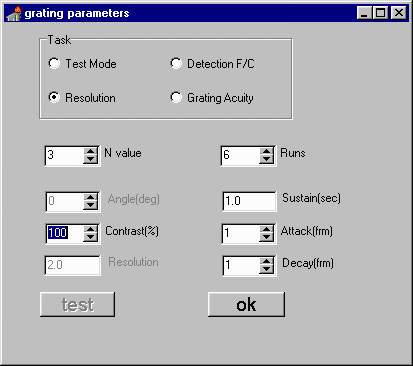
We may not have the best names for the different task modes but currently.
- Resolution task - Means that the grating is presented with either vertical or horizontal orientation. The subject responds with which orientation they think it is. Below threshold we would expect them to guess correctly %50 of the time. However horizontal and vertical thresholds are likely to be different so usually both horizontal and vertical stimuli are present during the test and both horizontal and vertical thresholds are determined.
- Detection F/C - means two presentations are made, one presentation is a blank field and the other contains a grating. The order is random and each presentation starts with an audio cue. The subject responds as to whether they think the grating was in the first or second presentation. Below threshold we would expect them to guess correctly %50 of the time.
- Grating Acuity - means the grating is presented and the subject simply responds as to whether or not they can see the grating.
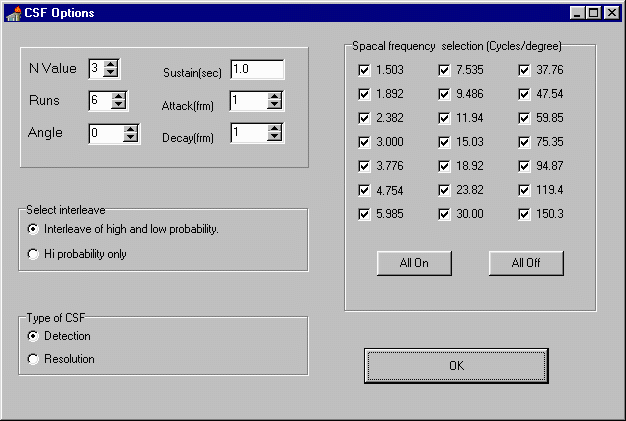
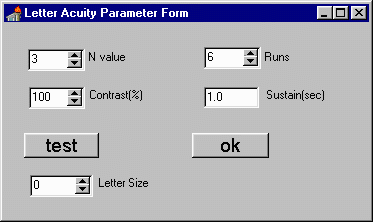
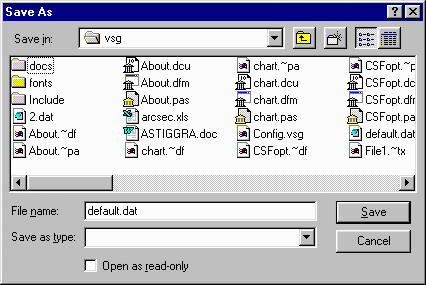
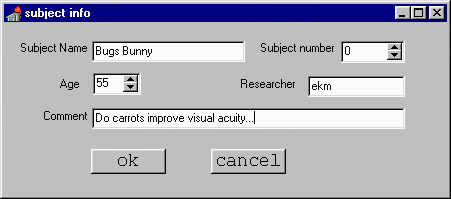
When you're done a text file containing the results will be displayed
on the PC screen. In the case of the CSF a scatter plot will be shown first.
Generally the data will be copied to another package (e.g. excel) for analysis.
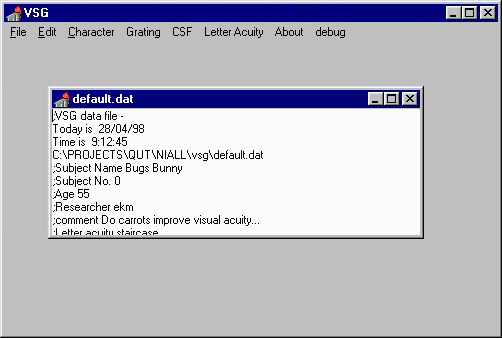
| ;VSG data file -
Today is 28/04/98 Time is 9:19:12 C:\PROJECTS\QUT\NIALL\vsg\demo.dat ;Subject Name Bugs Bunny ;Subject No. 0 ;Age 55 ;Researcher ekm ;comment Do carrots improve visual acuity... detection - H/V interleaved Y/N response ;Interleaved horizontal and vertical staircases ;Runs 6 ingore 2 ;vert ;turn 1 at 16 ;horz ;turn 1 at 16 ;vert ;turn 2 at 15 ;vert ;turn 3 at 16 midpoint 15.50 ;horz ;turn 2 at 15 ;vert ;turn 4 at 15 midpoint 15.50 ;horz ;turn 3 at 16 midpoint 15.50 ;vert ;turn 5 at 16 midpoint 15.50 ;horz ;turn 4 at 15 midpoint 15.50 ;horz ;turn 5 at 16 midpoint 15.50 ;vert ;turn 6 at 15 midpoint 15.50 ;vertical staircase finished ;horz ;turn 6 at 15 midpoint 15.50 ;horizontal ;staircase finished vert result - step 15.50 logmar-0.25 horz result - step 15.50 logmar-0.25 |
An example data file is in the gray box on the left. The
format of this file will change with future development. Much of it is
for validating and debugging. Most people will just want the results and
the end of the file.
The file header includes the file name, creation time, creation date and details entered into the subjects details box. Reading on you can see this was a detection task with horizontal and vertical gratings being interleaved. I requested 6 runs and the program ignored the first two for reasons stated earlier. The turns were logged so the results can be verified manually if need be. The turns and midpoints are logged as step numbers not Logmar values. The numbers can be translated to Logmar by the formula :- logmar=-1.3-Number*0.1 |